5 Sep 2011
SPIN Farming Basics: a book review
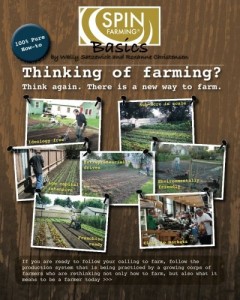 I have something to share in this post which I think is hugely exciting and which I think you are going to enjoy. A while ago I was sent a book called ‘SPIN farming basics: how to grow commercially on under an acre’ by Wally Satzewich and Roxanne Christensen. The book describes itself as a “step-by-step learning guide to the sub-acre production system that makes it possible to gross $50,000+ from a half-acre”. SPIN, which stands for ‘Small Plot Intensive’ (their website is here), has the feel of an important, big, and timely idea, and it is one that fits into Transition beautifully. So what is it?
I have something to share in this post which I think is hugely exciting and which I think you are going to enjoy. A while ago I was sent a book called ‘SPIN farming basics: how to grow commercially on under an acre’ by Wally Satzewich and Roxanne Christensen. The book describes itself as a “step-by-step learning guide to the sub-acre production system that makes it possible to gross $50,000+ from a half-acre”. SPIN, which stands for ‘Small Plot Intensive’ (their website is here), has the feel of an important, big, and timely idea, and it is one that fits into Transition beautifully. So what is it?
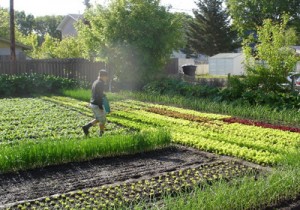 At the moment, when contemplating urban food production, the models that are used tend to be allotments, community gardens, planting productive trees or forest gardens, private gardens or even, perhaps, rooftop gardens. Commercial urban market gardens tend to be thought of as needing to be on a larger scale and requiring significant infrastructure. SPIN is based on the idea of ‘patchwork farming’, of seeing unused areas of urban land as having the potential to be worked commercially, viewed through the eyes of a commercial grower rather than someone growing for a hobby. This is a profound shift of emphasis and one that I find very exciting. Here is a short talk by SPIN farmer Paula Sobie of City Harvest which gives her take on what SPIN farming is:
At the moment, when contemplating urban food production, the models that are used tend to be allotments, community gardens, planting productive trees or forest gardens, private gardens or even, perhaps, rooftop gardens. Commercial urban market gardens tend to be thought of as needing to be on a larger scale and requiring significant infrastructure. SPIN is based on the idea of ‘patchwork farming’, of seeing unused areas of urban land as having the potential to be worked commercially, viewed through the eyes of a commercial grower rather than someone growing for a hobby. This is a profound shift of emphasis and one that I find very exciting. Here is a short talk by SPIN farmer Paula Sobie of City Harvest which gives her take on what SPIN farming is:
SPIN farming strips out any talk of politics or ideology that underpins approaches such as organics or permaculture, stating “think in terms of a production system, not a belief system”, although it doesn employ organic techniques. It can start on parcels of land as small as 1,000 square feet, and can be spread across a number of pieces of land. It is a commercial operation, albeit a small and decentralised one.
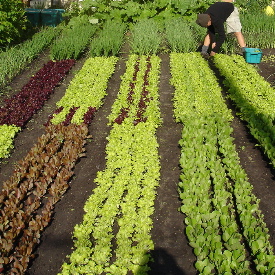 Its focus is on maximising output and profit for the grower. It weaves in intensive relay cropping practices, achieving a balance between high-value and low-value crops, “highly regimented harvesting techniques” and direct marketing. Unlike conventional farming, its start-up costs are low. The authors argue that the key to viability is focusing on high-value crops, such as spinach, carrots, fresh herbs, lettuce, a variety of leafy greens, radishes, scallions and chard, direct selling and being based within the community you are feeding.
Its focus is on maximising output and profit for the grower. It weaves in intensive relay cropping practices, achieving a balance between high-value and low-value crops, “highly regimented harvesting techniques” and direct marketing. Unlike conventional farming, its start-up costs are low. The authors argue that the key to viability is focusing on high-value crops, such as spinach, carrots, fresh herbs, lettuce, a variety of leafy greens, radishes, scallions and chard, direct selling and being based within the community you are feeding.
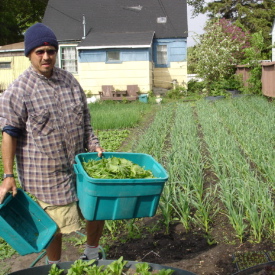 What is so brilliant about ‘SPIN Basics’ is that it is not just an idea, an aspiration, rather it is set out as a ‘read-this-then-get-to-it’ guide for the would-be grower, which itemises costs and the kinds of returns you can expect from successful SPIN plots on a range of scales. It is here that the reader starts to get a sense of the potential of all of this to underpin a revolutionary rethink in how urban land use is conceived. Although the figures given are all in dollars, they are compelling. One person, working 1,000 -5,000 square feet could expect a potential gross revenue of $3,900 – $18,000. Two people working fulltime on 10,000 to 20,000 square feet could expect a potential gross revenue of $36,000 -$72,000.
What is so brilliant about ‘SPIN Basics’ is that it is not just an idea, an aspiration, rather it is set out as a ‘read-this-then-get-to-it’ guide for the would-be grower, which itemises costs and the kinds of returns you can expect from successful SPIN plots on a range of scales. It is here that the reader starts to get a sense of the potential of all of this to underpin a revolutionary rethink in how urban land use is conceived. Although the figures given are all in dollars, they are compelling. One person, working 1,000 -5,000 square feet could expect a potential gross revenue of $3,900 – $18,000. Two people working fulltime on 10,000 to 20,000 square feet could expect a potential gross revenue of $36,000 -$72,000.
If the Transition of our local economies is going to work, it will need to find ways of creating a new resilient and more localised infrastructure in such a way that it is commercially viable, creates livelihoods, creates reskilling and employment opportunities for young people and which feels like it adds to a place, makes it more beautiful, more interesting, more diverse. You can easily imagine Transition initiatives identifying potential SPIN sites, training young people in the techniques, providing a central resource of tools, and helping with the marketing.
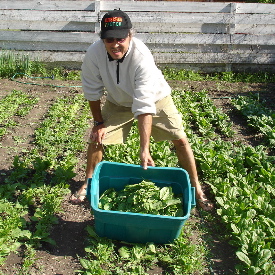 At the 2011 Transition Network conference at Hope University in Liverpool, I walked around the site each day looking at the huge areas of lawns and thinking in these days where students are expected to leave university with a debt of over £50,000, rethinking those lawns as SPIN farming plots would tick many, many boxes. A while ago I gave a talk at the Environment Agency in Bristol about Transition. Their site sits surrounded by masses of lawn, and I remember telling them that in 10 years it might be that the fact they now operate as a market garden is the only reason anyone still comes to work for them. Again, SPIN farming, more than anything I have come across yet, sets out how that could become a reality. As you can tell by now, I am quite fired up about it.
At the 2011 Transition Network conference at Hope University in Liverpool, I walked around the site each day looking at the huge areas of lawns and thinking in these days where students are expected to leave university with a debt of over £50,000, rethinking those lawns as SPIN farming plots would tick many, many boxes. A while ago I gave a talk at the Environment Agency in Bristol about Transition. Their site sits surrounded by masses of lawn, and I remember telling them that in 10 years it might be that the fact they now operate as a market garden is the only reason anyone still comes to work for them. Again, SPIN farming, more than anything I have come across yet, sets out how that could become a reality. As you can tell by now, I am quite fired up about it.
‘SPIN farming basics’ is just one of the books that SPIN produce. It isn’t a step-by-step growing guide, rather it is an overview book on how to run such an operation. I have no way of gauging whether their figures are accurate and how they might translate into the UK context. I’m also not sure what they do about slugs. There is also, I guess, a distant danger that should this really take off it might edge out more egalitarian forms of urban land use, such as allotments and community gardens. But even if they are only half right about their potential yields, it is still an impressive approach, and it calls for a powerful shift in focus for urban growers. In the wake of the recent riots in a number of English cities, I am struck by the potential of this approach to shift thinking about how to create viable social enterprises and a sense of purpose for young people. It has certainly got my brain ticking over pretty rapidly.
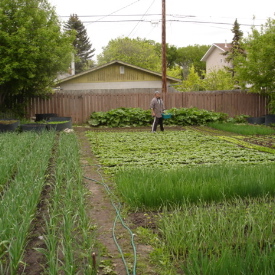 As the authors put it, “once you put on SPIN glasses, you start seeing dollar signs all over vacant and underutilised patches of land”. As economic contraction worsens, and peak oil starts to bite, this form of land use will become the norm, as it has done every time in history that societies have faced similar sets of circumstances. The obstacle to getting started has always been how to make this stuff viable. That obstacle, thanks to the work of the SPIN folks, would appear to no longer exist, or at least to be greatly diminished. If you don’t do it someone else will, and they likely won’t do it in a way rooted in social justice, community benefit, food security and Transition. This is an important window in time to get moving on this.
As the authors put it, “once you put on SPIN glasses, you start seeing dollar signs all over vacant and underutilised patches of land”. As economic contraction worsens, and peak oil starts to bite, this form of land use will become the norm, as it has done every time in history that societies have faced similar sets of circumstances. The obstacle to getting started has always been how to make this stuff viable. That obstacle, thanks to the work of the SPIN folks, would appear to no longer exist, or at least to be greatly diminished. If you don’t do it someone else will, and they likely won’t do it in a way rooted in social justice, community benefit, food security and Transition. This is an important window in time to get moving on this.
This is a revolutionary text, an incendiary call to rethink urban land use in a way that ticks everyone’s boxes. I can’t recommend it too highly.
Here is another film about SPIN farmer Curtis Stone in Kelowna, BC, Canada:
It is rather hard to tell from the SPIN website which of the books they offer is this one… so for the last time ever, here is a link to the book on Amazon…. it is quite pricey, but one to get and share with as many people as you can…
Andy in Germany
5 Sep 9:08am
It sounds like a great idea. How well does it fit into permaculture methods of having mixed culture in your beds?
Mark forskitt
5 Sep 10:40am
Yes that sounds quite plausible. Small plots are perfectly workable. The gross figures are probably a little deceptive. This approach seems to rely on buying in fertility and that could be a big cost. Actual net revenue is going to be somewhat smaller. Still a whole lot better than unemployment and all that goes with it psychologically and socially.
Ooooby.org : Out of our own backyards
5 Sep 11:56am
[…] been following Rob Hopkin’s Transition Towns blog for a few years now, and today’s post caught my attention big time! This is all about making an income from farming small plots of land […]
Curtis
5 Sep 9:23pm
Cost of fertility is minimal compared to the revenues. SPIN farming projections are actually quite conservative to what can actually be generated. We currently produce over 200 lbs of salad greens a week off of 6,500 square feet of land. That land is our most intensive site out of our .8 of an acre. Costs of inputs are marginal, when compared to our farms earnings. We’ve spent less than $900 on organic implements to generate over $38,000 of income thus far (April 23, 2011 – Sept 5, 2011). Since everything on our operation is done by bicycles, our only other expense is seed, in which we’ve spent about $2000 for our entire season. I should also point out, that we still have 2 months of growing season left, and will most likely exceed $55,000 for our 2011 growing season. This is two people working. Myself 40-60 hours a week, and my co-worker 30-40 hours a week.
I have been doing this for two years now, and I’ve shown that it’s not only possible to make a great living off farming land you don’t own in a city, but earn a living in a more sustainable way, and pave a way for a new type of localized economic system that is rooted in local food production.
Check out my website http://www.greencityacres.com
Joanne Poyourow
6 Sep 2:54am
The SPIN idea spun through our area some time ago and I was underwhelmed. Reasons:
(1) in websites/handouts they are touting these big income figures which are dependent upon high-end purchasers such as restaurants in order to achieve them. already in our area the high-end restaurants are struggling, thus this income stream is an unsustainable expectation.
(2) as Mark Forskitt pointed out they are counting on “buying fertility” — the model doesn’t necessarily emphasize growing their own. when they try growing fertility on the same land, their saleable volume will plummet.
(3) their focus on “high income crops” means almost entirely leafy greens and herbs. thus from a resilience standpoint, local people are going to feel pretty hungry. (compare to Carol Deppe, who focuses on 5 calorie crops to alleviate hunger & for feeling “full”), and (4) yes, their books are pricey (which feels a bit scam-y).
All those negatives aside, we could view the SPIN model as “getting a foot in the door.” I would coach any prospective SPIN farmer to expect (a) that income figures will start lower than SPIN tells you, and that they will come down further as the economy spirals inward (ref: Stoneleigh), (b)learn to grow your own fertility from someone like Jeavons so that you don’t have to buy it long-term, and (c) eventually urban farming will have to include a polyculture of calorie-dense crops, thus lower-income crops, lower-turnover crops than the SPIN model would have you expect.
Another route: Here in Los Angeles, some people are setting up small businesses to maintain edible landscaping, as an alternative to the old-fashioned lawn mowing services.
Richard
6 Sep 8:13am
I agree with Joanne and Andy that SPIN is a good idea to get a ‘foot in the door’ but it strikes me that it might not be a great fit with Permaculture. There is not much emphasis on diversity and care for the soil, and fossil fuel use seems to have a prominent role.
shane
6 Sep 9:11am
Hi Joanne, the edible landscaping sounds interesting, do you have links?
SPIN also sounds interesting, not too difficult to tweak… and i wonder if the idea can be used for other sectors?
Andrew Ramponi
6 Sep 11:12am
Fertility and polyculture issues aside the significant aspect of the Spin farming concept as I see it is the business for profit focus. This involves the right crops, refrigeration and a variety of other techniques.
Although on the surface apparently all about a sensible way to grow food, it is I think fundamentally a business idea. And possibly quite a good one.
The difficulty is that many people into permaculture and growing food find their environmental ethos often at odds with making money. It can be a real internal struggle to cultivate an appropriate and necessary business-for-profit attitude along with the cultivation of ones crops!
For example, supermarkets know presentation is paramount and customers will pay much more than a product perhaps deserves if it offers subtle visual cues reflecting it’s superiority. Descriptions and labels help greatly. Yet, many (not all) producers at farmers markets seem to completely ignore this, relying on conveying their sense of integrity alone to do the selling. Being in competition with other producers is another sometimes troublesome business attitude that SPIN emphasises as important.
That said I think SPIN farming has much to offer, especially in exciting interest, using space efficiently, making money eyc etc; as though does vertical gardening, square foot gardening or any other concept ideas for producing food.
My main grudge with the organisation is the price charged for the guides; from memory about double what I paid 3 years ago. Although very detailed $80 for an 80 page pdf is extremely expensive and I think hard to justify.
I am tempted to offer to email the pdf’s to anyone who wants a copy….but…
shane
6 Sep 12:43pm
Andrew, i agree about issues around profit making, just wanted add / emphasise that profit making is also the exciting bit…. not profit making as such but that reappropriation of land to food productive spaces can be done, with localised tweaks, in a financially self sustaining way… could just be TI’s wanting to self fund (sub)urban food growing projects. i’d like to also find ways that the transport, waste, etc groups can self fund some of their projects…. opens up the chance of remunirating dedicated TI volunteers and ramping up mainstream penatration of TI projects.
Matt
6 Sep 2:17pm
As far as I know there is nothing in the rule book about permaculture and profits. One of the main principles of permaculture, often underplayed, is Obtain a yield. We need systems that are focussed on production as well as holistic goals. Urban farming examples that i know of rely on fertility from outside the system because it is an abundant resource (another tick in the permaculture manual)
I see this as a snapshot solution to the current economic madness. As things change, all the economic drivers will change as well. Yes we may have to grow more carbs and less cilantro in the future, but then prices will adjust accordingly, at the moment it is simply not viable to compete with high energy embodied carbohydrates from industrial farms. In the meantime here is a great idea that will be awakening peoples interest in the land, encouraging new thinking into food production, expanding access to land, and growing healthy food!
The Book That’s Launched Hundreds of New “Urban” Farm Careers — City Farmer News
6 Sep 4:46pm
[…] Good review in Transition Culture, Sept 5, 2011 here. […]
Curtis
6 Sep 4:48pm
Well said Matt.
To the other comments.
Nobody has ever said that SPIN is the ultimate sustainable agricultural system. I like what was said about a ‘foot in the door’. It is a step in the right direction, and for myself personally, it’s a great way to make a living. I feel that I am a part of actual change in my day to day life, opposed to working a job that I hate, to fund my work in Transition and activism.
There are many SPIN models that don’t rely on high end restaurant demand. Wally, the creator of SPIN farming, barely deals with any high end restaurants at all. The bulk of his sales come from farmers markets. That can be done anywhere. Where as mine sales are divided into 60% restaurant, 30% farmers markets, 10% CSA. Those markets can shift with demands, as it is fairly easy for a SPIN farmer to change their production with a small land base.
Regarding fertility again, this system can be easily implemented by building ones own fertility, as per a Biointenvive system. Ultimately, any system such as this are highly labour intensive, and in my opinion, at least where I live, the price of food isn’t nearly high enough to justify those labour cost… yet. But they definitely will be soon enough. In a city, we have access to endless amounts of organic waste, and once more cities allow urban intensive composting, fertility won’t be an issue. Just look at Will Allen in Milwaukee. Though Will doesn’t call himself a SPIN farmer, his idea of bringing in entirely new soil, can easily work within SPIN. Like I said before, the price of food will dictate all of that.
Josef Davies-Coates
6 Sep 10:17pm
Surprised that you’ve only recently come across SPIN farming.
This is also an interesting initiative in Africa:
http://www.oneacrefund.org/
Josef Davies-Coates
6 Sep 10:24pm
Also worth pointing out that salad crops are the mainstay of most successful commercial urban food projects, including OrganicLea and Growing Communities in London, and for good reason; salad crops are valuable, grow well in shady urban conditions and have a long season.
Josef Davies-Coates
6 Sep 10:25pm
@Andrew I’d happily receive the pdf in my inbox josef at uniteddiversity.com 😉
Shane
6 Sep 11:45pm
Andrew, would also like to share PDF shanehughes@lycos.com
pete
8 Sep 7:59pm
I have been looking at spin farming on and off over the years. I think it is a good initiative for building a local food production unit. It could be helpful to bring employment to unemployed. I changed my bed system to two foot by fifty foot beds. Easier to work out qty of plants needed.
Curtis
8 Sep 9:44pm
Not only are salad crops important for a SPIN farmer, but they’re also important to a city in a peak oil scenario. It makes no sense to grow perishable crops far from where they’re consumed, because they suffer spoilage in transit. This is why the focus of any urban farmer working in a city, should have most of their production dedicated to fast growing perishable crops, like salad greens, summer squash, radish, micro greens, and sprouts. Not only is growing wheat, potatoes, and winter squash in a city not profitable, it’s also not practical. If a crop can be stored and suffers little spoilage in transit, then it doesn’t need to be grown so close to where it’s consumed. If you look at Cuba during the “special period”, the first things they grew, in order to feed people right away, were quick growing crops like greens. Proper planning of crop selection is not only an important part of energy decline, it’s also a great economic model for a farmer who ultimately needs to make a living for their efforts and to survive in this economy.
Daniel
23 Sep 10:18pm
Thanks for reviewing the book and getting the word about SPIN to a wider audience. This is my first year SPIN farming and hopefully it will be great. It makes me a bit sad that the permaculture camp always seem to bag any practice that does not fit into the permaculture model 100%. This attitude and passive aggressive behaviour does not fit very well into permaculture ethics. SPIN is a well functioning model based on tried and tested innovational market garden ideas, that were used in Europe throughout the late 19th century and early 20th century prior to fossil fuels. The model is also based on using land on a temporary basis so the idea of growing anything other than annuals is not possible. There is plenty of room in the SPIN model to use polyculture and ground cover crops to protect the soil. Just remember..there are a lot of people out there working their arses off to make their communities a better and healthier place by providing locally grown food. You just need to ask yourself…where does the food I buy come from? and how many people in my community do I provide healthy food for? before making critical comments about other peoples food production methods.
Jo Homan
26 Sep 10:04pm
What I would like to see is a no-dig, high-mulch, perennial plant version of this. For me a more interesting question wouldn’t be “what cash crops will bring me profits right now?” (as Josef points out there’s plenty of people already doing that) but “what would intensively managed agroforestry look like?” Because that’s the kind of long term thinking we need and as far as I know no one’s yet doing it.
I’d also say that people need to be educated away from cos lettuce and towards the many MANY edible leaves that grow abundantly everywhere. If people could recognise the existing edible landscape they wouldn’t need to buy expensive bags of lettuce.
Josef Davies-Coates
26 Sep 10:47pm
“what would intensively managed agroforestry look like?”
Good question.
Best UK example I’m aware of is the Primrose Earth Centre in Wales:
http://www.primroseearthcentre.co.uk/sustainable_food_production.htm
Apparently they make £20k a year from 1.5 acres.
Jo Homan
26 Sep 11:12pm
I can’t see from this what they’re actually growing, but “95 different varieties of fruit and nut trees” sounds pretty cool. I think I see perennial broccoli and tree onions. Very interesting, thanks.
Josef Davies-Coates
27 Sep 12:14am
See also Bridge Farm (who are actually Primrose Earth Centre) who feature as Case Study 3 which starts on p18 of the Ecological Land Co-op’s excellent report ‘Small is Successful’:
http://www.ecologicalland.coop/sites/ecologicalland.coop/files/Small_is_Successful.pdf
Josef Davies-Coates
27 Sep 12:45am
See also this report from the Soil Association:
‘Primrose Organic Centre energy descent and Gaia farming’:
http://www.soilassociation.org/LinkClick.aspx?fileticket=p0VhTjN0jyY%3D&tabid=152
Curtis
28 Sep 4:40pm
Agroforestry and food forest systems are great… If you own land. But what about all the landless peasants that occupy the majority of cities? That’s why SPIN is so relevant to the times we’re living in.
Jo Homan
28 Sep 6:33pm
The plants we grow don’t seem to mind that we don’t own the land! We have eight growing projects in public places in Finsbury Park, London.
Diane Emerson
10 Feb 8:21pm
I too think that SPIN farming with salad greens and fancy varieties is temporary – and that’s OK by me. It will provide a fast way for urban spaces to be converted to growing food crops, and gives a great incentive for people to get involved in growing food. Looking longer term, I am promoting the planting of nut trees in cities, because we will be needing the high density food value and protein (2-3 times the protein of an egg gram for gram) which nuts provide. I am committed to this effort, and am buying nut trees for people who will plant and care for them and allow the nuts to be shared with the local community. Some people are guerrilla planting them in parks and school properties. Others are incorporating them into their community gardens and community orchards. If you would like to participate, please contact me. You share your idea, I decide how many trees or $ to give for your project, and we go from there. Hazelnuts are one of my favorites, as they produce within 3 years. But you decide which nuts you want.
Diane Emerson
13 Feb 1:35am
Here is my e-mail: dianeemerson at Yahoo.com